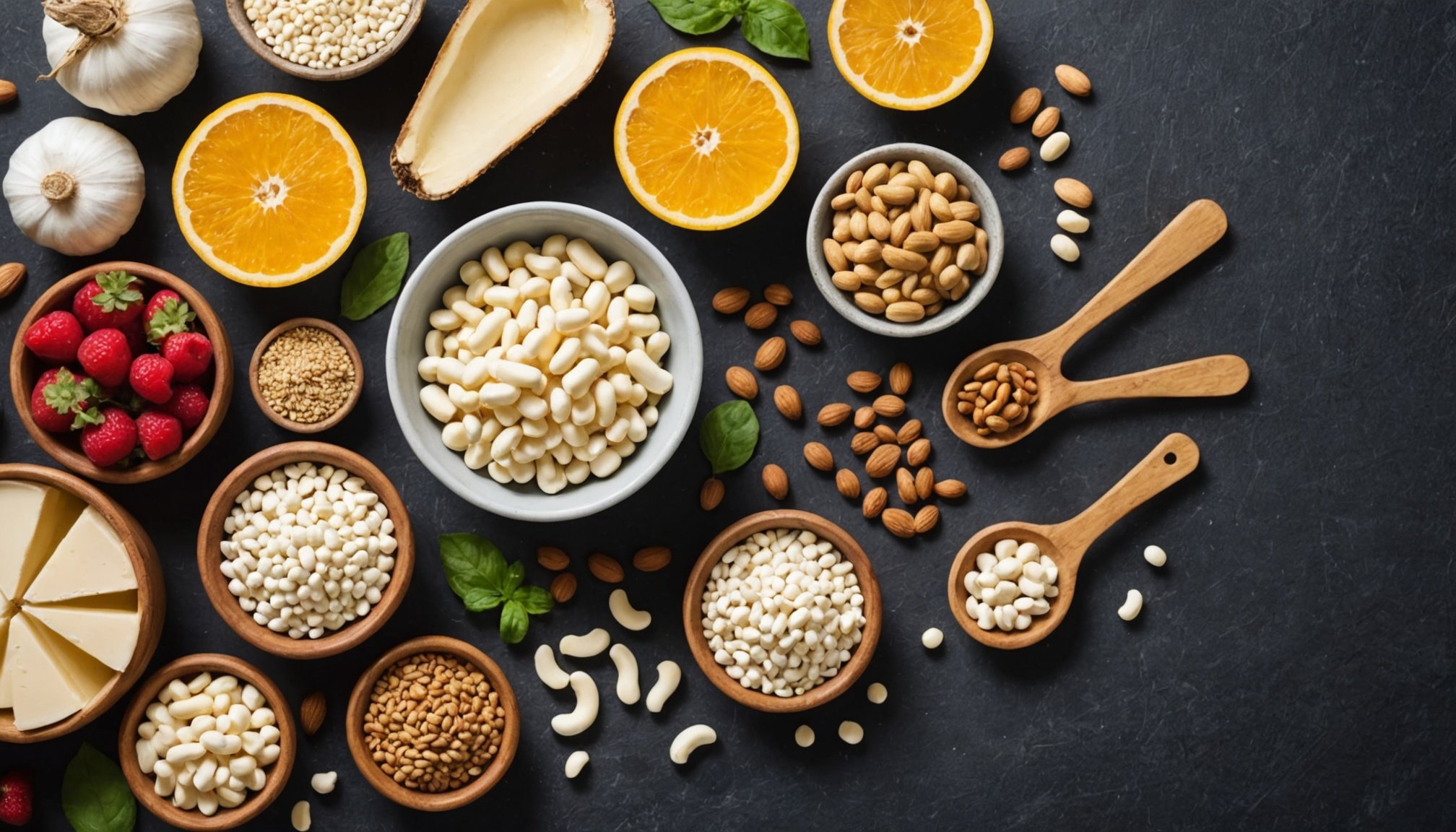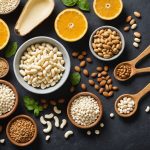Top Non-Dairy Calcium-Rich Foods to Boost Bone Health in Menopausal Women
As women enter menopause, one of the significant health concerns is the decline in bone health, which can lead to conditions like osteoporosis. While dairy products are often touted as the best sources of calcium, there are numerous non-dairy foods that can provide the necessary calcium and other essential nutrients to support bone health. Here’s a comprehensive guide to help you navigate these options.
Understanding the Importance of Calcium for Bone Health
Calcium is a crucial mineral for maintaining strong bones, and its importance increases during menopause. Postmenopausal women need approximately 1,200 milligrams of calcium daily to support bone health, which is higher than the recommended intake for younger adults.
Also to discover : Discover the Best Natural Remedies to Illuminate Dark Circles Under Your Eyes
“Calcium builds strong bones, but vitamin D helps the body absorb calcium. That’s why postmenopausal women need 1,200 milligrams calcium and at least 400 IU to 600 IU vitamin D daily for better bone health,” explains Kathryn Diemer, MD, an osteoporosis specialist.
Non-Dairy Sources of Calcium
While dairy products are rich in calcium, there are many non-dairy alternatives that can provide this essential mineral.
Also read : Mindful Meditation: A Pathway to Curbing Impulsive Shopping and Embracing Conscious Fashion Choices
Leafy Greens
Leafy greens such as kale, spinach, collard greens, and bok choy are excellent non-dairy sources of calcium. Here’s a breakdown of the calcium content in some of these vegetables:
| Vegetable | Serving Size | Calcium Content (mg) |
|---|---|---|
| Kale | 1 cup cooked | 200-250 mg |
| Spinach | 1 cup cooked | 200-250 mg |
| Collard Greens | 1 cup cooked | 250-300 mg |
| Bok Choy | 1 cup cooked | 150-200 mg |
These vegetables are not only rich in calcium but also in antioxidants, which help combat oxidative stress and support overall health.
Fortified Plant-Based Milk
Fortified plant-based milks such as soy milk, almond milk, and oat milk are great alternatives to dairy milk. Here are some examples:
- Soy Milk: 1 cup fortified soy milk contains approximately 300-400 mg of calcium.
- Almond Milk: 1 cup fortified almond milk contains about 450-500 mg of calcium.
- Oat Milk: 1 cup fortified oat milk contains around 350-400 mg of calcium.
Nuts and Seeds
Nuts and seeds are another rich source of calcium. Here are some examples:
- Almonds: 1 ounce (about 23 almonds) contains around 70-80 mg of calcium.
- Cashews: 1 ounce (about 16-18 cashews) contains approximately 30-40 mg of calcium.
- Sesame Seeds: 1 tablespoon of sesame seeds contains about 80-100 mg of calcium.
- Tahini: 2 tablespoons of tahini contain around 120-150 mg of calcium.
Tofu and Edamame
Tofu and edamame are soy products that are rich in calcium. Here’s a look at their calcium content:
- Tofu: 3 ounces of tofu can contain up to 200-300 mg of calcium, depending on the brand and type.
- Edamame: 1 cup cooked edamame contains about 200-250 mg of calcium.
Other Essential Nutrients for Bone Health
While calcium is crucial, other nutrients also play significant roles in maintaining bone health during menopause.
Vitamin D
Vitamin D is essential for calcium absorption and bone mineralization. Here are some non-dairy sources of vitamin D:
- Fortified Foods: Many plant-based milks and cereals are fortified with vitamin D.
- Fatty Fish: While not non-dairy, fatty fish like salmon and mackerel are rich in vitamin D. For those who do not consume fish, fortified foods are a good alternative.
- Sun Exposure: Sunlight exposure is a natural way to produce vitamin D, but it may not be sufficient for everyone, especially during winter months or for those who use sunscreen regularly.
Magnesium
Magnesium is another critical mineral for bone health. It helps in the conversion of vitamin D to its active form and supports calcium absorption.
“Magnesium is involved in over 300 enzymatic actions in the body, and almost half of the US population is deficient,” explains Johanna Katz, M.S., RDN. “Magnesium is a key regulator of converting vitamin D to the active form 1-25 dihydroxyvitamin D, and without active vitamin D, calcium cannot be properly absorbed in bone,” she adds.
Here are some non-dairy sources of magnesium:
- Nuts and Seeds: Almonds, cashews, pumpkin seeds, and sunflower seeds are rich in magnesium.
- Whole Grains: Whole grains like brown rice, quinoa, and whole wheat bread contain magnesium.
- Leafy Greens: Spinach, kale, and collard greens are also good sources of magnesium.
Omega-3 Fatty Acids
Omega-3 fatty acids, particularly EPA and DHA, have anti-inflammatory properties that can help alleviate joint pain and support heart health, which is crucial during menopause.
“Fatty fish, flaxseeds, and walnuts contain omega-3s that may benefit skeletal health,” according to the British Journal of Nutrition.
Practical Tips for Incorporating These Foods into Your Diet
Here are some practical tips to help you incorporate these non-dairy calcium-rich foods into your diet:
Balanced Diet
- Eat a Variety: Include a variety of fruits, vegetables, whole grains, legumes, healthy fats, and lean proteins in your diet to ensure you get a wide range of nutrients.
- Meal Planning: Plan your meals to include calcium-rich foods at each meal and snack. For example, start your day with fortified plant-based milk and oatmeal, and include leafy greens in your lunch and dinner.
Supplements
- Consult Your Doctor: If you find it challenging to get enough calcium from your diet, consider consulting your doctor about calcium supplements. Remember, it’s best to take calcium supplements in doses not exceeding 500 mg at a time to ensure better absorption.
Lifestyle Changes
- Exercise Regularly: Regular physical activity, especially weight-bearing exercises, can help support bone health.
- Avoid Harmful Habits: Avoid smoking and excessive alcohol consumption, as these can contribute to bone loss and other health issues.
Real-Life Examples and Anecdotes
Many women have found significant relief from menopausal symptoms by incorporating these non-dairy calcium-rich foods into their diets.
For instance, a study by the Physicians Committee found that postmenopausal women who followed a low-fat, vegan diet with half a cup of cooked soybeans daily experienced a significant reduction in hot flashes. This diet also helped improve insulin sensitivity and reduce the risk of heart disease.
Maintaining strong bones during menopause is crucial, and it doesn’t have to rely solely on dairy products. By incorporating a variety of non-dairy calcium-rich foods into your diet, along with other essential nutrients like vitamin D, magnesium, and omega-3 fatty acids, you can significantly support your bone health.
Remember, a balanced diet combined with regular exercise and healthy lifestyle choices can go a long way in preventing osteoporosis and other menopause-related health issues.
Detailed List of Non-Dairy Calcium-Rich Foods
Here is a detailed list of non-dairy foods that are rich in calcium:
-
Leafy Greens:
-
Kale: 1 cup cooked = 200-250 mg
-
Spinach: 1 cup cooked = 200-250 mg
-
Collard Greens: 1 cup cooked = 250-300 mg
-
Bok Choy: 1 cup cooked = 150-200 mg
-
Fortified Plant-Based Milk:
-
Soy Milk: 1 cup = 300-400 mg
-
Almond Milk: 1 cup = 450-500 mg
-
Oat Milk: 1 cup = 350-400 mg
-
Nuts and Seeds:
-
Almonds: 1 ounce = 70-80 mg
-
Cashews: 1 ounce = 30-40 mg
-
Sesame Seeds: 1 tablespoon = 80-100 mg
-
Tahini: 2 tablespoons = 120-150 mg
-
Tofu and Edamame:
-
Tofu: 3 ounces = 200-300 mg
-
Edamame: 1 cup cooked = 200-250 mg
-
Other Foods:
-
Fortified Orange Juice: 6 ounces = 200-260 mg
-
Canned Salmon: 3 ounces = 180 mg
-
Cooked Broccoli: 1/2 cup = 40 mg
-
Cooked Spinach: 1/2 cup = 100 mg
By incorporating these foods into your diet, you can ensure you are getting the calcium and other nutrients necessary for strong bones during menopause.
Table: Comparative Calcium Content in Non-Dairy Foods
| Food | Serving Size | Calcium Content (mg) |
|---|---|---|
| Kale | 1 cup cooked | 200-250 |
| Spinach | 1 cup cooked | 200-250 |
| Collard Greens | 1 cup cooked | 250-300 |
| Bok Choy | 1 cup cooked | 150-200 |
| Soy Milk | 1 cup | 300-400 |
| Almond Milk | 1 cup | 450-500 |
| Oat Milk | 1 cup | 350-400 |
| Almonds | 1 ounce | 70-80 |
| Cashews | 1 ounce | 30-40 |
| Sesame Seeds | 1 tablespoon | 80-100 |
| Tahini | 2 tablespoons | 120-150 |
| Tofu | 3 ounces | 200-300 |
| Edamame | 1 cup cooked | 200-250 |
| Fortified Orange Juice | 6 ounces | 200-260 |
| Canned Salmon | 3 ounces | 180 |
| Cooked Broccoli | 1/2 cup | 40 |
| Cooked Spinach | 1/2 cup | 100 |
This table provides a quick reference to the calcium content in various non-dairy foods, helping you plan your diet more effectively.











